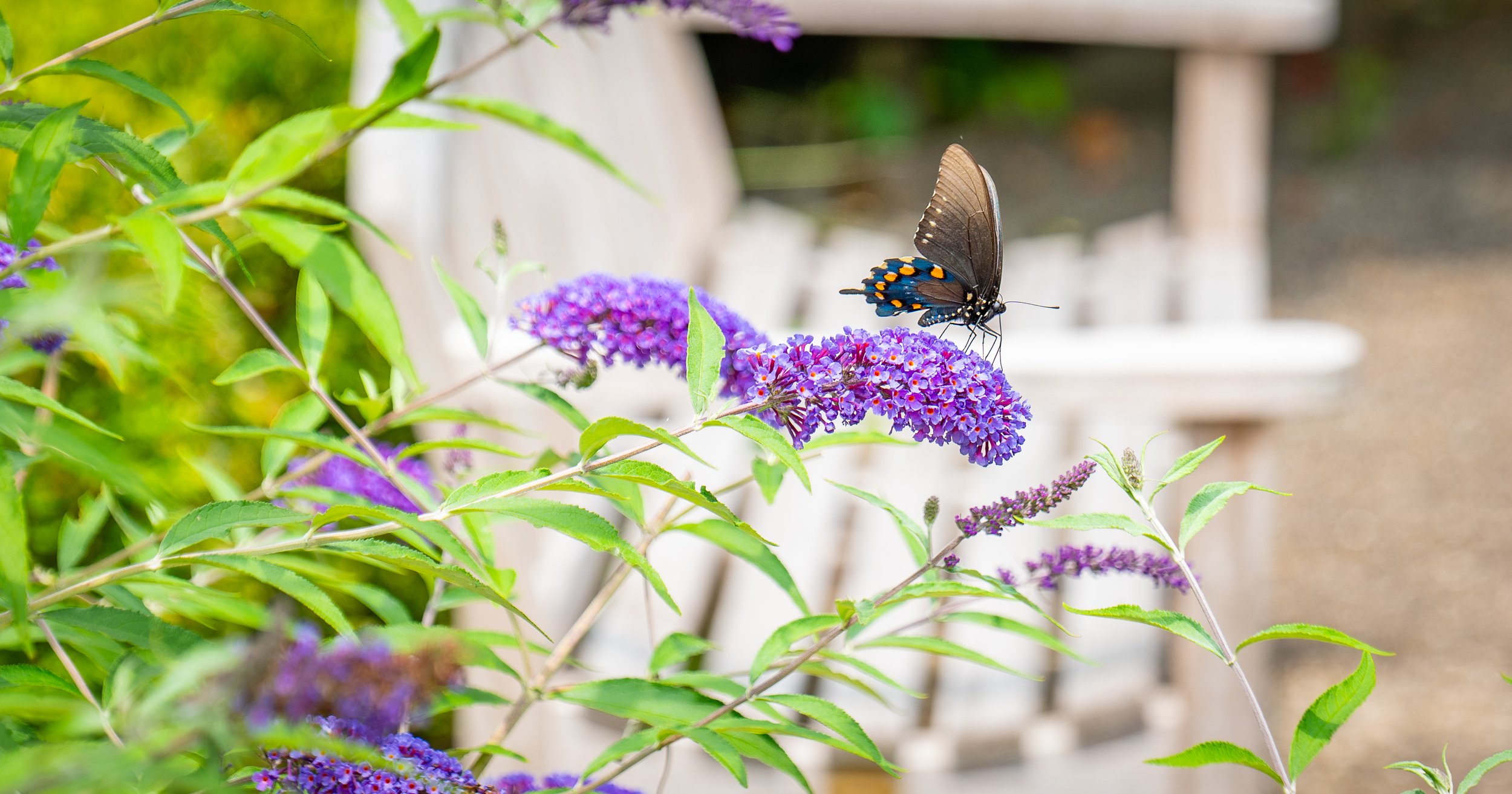
Gardens
Fernwood is a special place where people and nature peacefully co-exist. Fernwood demonstrates the possibility of a world in harmony with nature and provides information to help make this a reality.
From the winter aconites of early spring through the asters and mums of fall, Fernwood is an ever-changing landscape of blooming plants. In April and May, visitors enjoy drifts of daffodils and primroses, and a wonderful variety of flowering trees and shrubs. Summer brings a rich diversity of shade and sun loving perennials, annuals, and herbs, plus many butterflies. Even after the first frosts of autumn, the gardens continue to delight with colorful displays of perennials and ornamental grasses.
Herb & Sensory Garden
The Stan Beikmann Herb and Sensory Garden was designed to engage visitors' senses and inform them about the many uses of herbs, present and past. More than 200 kinds of herbs are displayed in an adapted English design. Occupying the center of the garden is a stone dovecote, a structure used historically to provide nesting sites for domesticated pigeons. The various beds feature plants used for seasonings, spices, teas, dyecloth, insect repellents and much more. This garden also includes a sensory trail with beds that appeal to our senses of smell, taste, sight, touch, and sound.
Bauer Terrace
Leaving the south side of the Visitor Center, guests step onto the Bauer Terrace. Tables and chairs provide a shady place to sit under a vine covered arbor that attracts hummingbirds as well as pipevine swallowtail butterflies that require the flowering pipevine to feed their larvae. The center Martin D. Gapshis Memorial Garden, designed by Craig Bergmann Landscape Design, features a formal planting of lavenders, boxwoods, and trellis work along with and espaliered pear tree. At the south end of the terrace, a copper roofed gazebo provides a panoramic view of the South Vista Garden.
Fern Conservatory
The Kay Boydston Fern House is named for Fernwood’s founder, who was a skilled grower, propagator, and hybridizer of ferns. Rocky cliffs occupy the center of this 1,000-square-foot conservatory, with a waterfall cascading down to a small pond at one end. More than 100 kinds of temperate ferns and other tropical plants grow in the rocks and nearby beds. A new addition in 2010 is a railway garden exhibit designed by Paul Busse of Applied Imagination that features tracks, one overhead and one at ground level.
Kathy's Garden & Wanda Franklin Entry Garden
These gardens are named in memory of two very special Fernwood supporters. Kathy's Garden is the first garden visitors see when they enter Fernwood's parking lot, and the adjacent Wanda Franklin Garden leads to the entrance to the Visitors Center.
The gardens are composed of a mixture of native and non-native perennials and grasses, arranged and designed by noted plantsman Roy Diblik of Northwind Perennial Farm in Burlington, Wisconsin. Roy has been growing plants and designing gardens for close to two decades, and has pioneered the philosophy of the Know Maintenance ® garden style, which emphasizes creating communities of plants that grow well together to minimize long-term maintenance. Roy has designed and installed several high-profile projects including the Sullivan Arch Garden at the Art Institute of Chicago, which won the Mayor's Award in 2010.
South Vista
Visitors access the South Vista Gardens via a wheel chair ramp or stairway from the Bauer Terrace. A lawn occupies the center of the area, and a paved path follows its perimeter. A twig gazebo in the southwest corner provides a place to rest near a butterfly larvae garden and ornamental grass garden.
Just below the Bauer Terrace, near the base of the stairway, is a garden pond and waterfall. The newly designed Streamside Border features a small stream that flows into a naturalistic pond where frogs, turtles, and other water creatures can be seen. The South Vista also features a beautiful seating area under the weeping katsura tree. Open space for activities.
Japanese Garden
The Japanese Garden takes visitors out of their own culture and lets them explore another. Funded by the Niles Garden Club, the garden was designed by Ben Oki and completed in 1979. Ben Oki is the Curator of Bonsai at the world-renowned Huntington Botanical Gardens in San Marino, California.
Fernwood's Japanese Garden is a variation of a Japanese dry garden. Gravel represents water and is raked to imitate the flow of the water. Benches around the edge of the garden can be used for sitting, meditating, and pondering the shapes, forms, and colors in the garden. Many of the forms are symbols. For example, the two islands in the gravel represent the "turtle" and the "crane," both of which symbolize longevity.
The Japanese people are very devoted to nature. Their gardens are works of art: different people can interpret them in different ways. Mr. Oki, in keeping with this tradition, designed the garden to leave room for the imagination of visitors.
Jean Hussey Memorial Gardens
In June of 1975, friends of the late Jean Hussey, wife of Mr. George Hussey of Niles, donated money in her name for the acquisition of an eleven acre tract of land to complete Fernwood. The land was designated as the Jean Hussey Memorial Gardens and is divided into several smaller planting areas. Bordering the garden are several handsome specimens of European weeping beech including the fern-leafed and tricolor varieties. Watch for renovation over the next few years.
Moore Woodlot & Daffodil Bowl
Separating the north and south gardens, the Moore Woodlot and Daffodil Bowl reflects the balance between gardens and natural areas at Fernwood.
Next to the Moore Woodlot, visitors are greeted by a winding, shady pathway through a grove of trees. This area changes dramatically during the year, showing how one can combine bulbs with other plants to create gardens with multi-season interest. In early spring the garden is ablaze with winter aconites and then with daffodils. In August a stunning display of hardy amaryllis appears as if from nowhere. Finally, in autumn, the turning leaves provide a final show of color, along with autumn crocus and colchicums.
Bordering the Hosta Bowl are several special trees, including two "living fossils," the dawn redwood and ginkgo.
Ravine Garden
On their first visit to what is now Fernwood, Kay and Walter Boydston saw the possibilities for developing the former owner's dumping ground. Although overgrown with tall weeds, the spot had all the ingredients needed for a rock garden: a variety of slopes, dry and wet spots, pools, rills, and ever-flowing springs–everything except the rocks.
Development of the garden began in the 1950s. From 1958 to 1966 the Boystons supervised the placement of several tons of tufa rock. These rocks formed the foundation and outcrops of the garden, providing pockets and crevices for the planting of Kay's favorite miniature and dwarf plants.
The garden has transformed into a naturalized setting with drifts of primroses and other moisture loving plants that have taken over the banks of its seven natural springs.
Home Fern Garden
While many gardens incorporate ferns as accent plants, this garden uses other plants to accent the ferns many of which were planted by our founder, Kay Boydston, hence giving this property its appropriate name.
Boxwood Garden
Originally a collection of small shrubs recommended for landscape use, this garden includes a border of 'Grand Rapids' and 'Handsworthy' boxwoods. The entrance features a cedar gate arbor marked with motifs of the Pennsylvania Dutch. Inside, beds of shade-tolerant groundcovers border the boxwood hedge. A sitting bench allows visitors to pause and enjoy the intimacy and serenity this spot provides. A flagstone patio marks the center of the garden, flanked by gates that invite exploration of what lies beyond.
With the generous support of Halbritter Wickens Funeral Services, in 2018 this garden was named the Halbritter Wickens Garden of remembrance and reflection.
Weir Lily Pond
The Weir Lily Pond, constructed in 1977 features a sunken walkway on the north side that allows children to enjoy the pond’s frogs without danger of falling in. Water plants and garden perennials provide color in summer, while a bench offers a place to pause and enjoy this tranquil setting. The pond is a memorial to Richard Weir, given by his family and friends.
North Vista
Clarence Godshalk, first superintendent of the Morton Arboretum designed Fernwood’s North Vista which features a series of naturalistic plantings and gardens that complement the adjacent woodlands. Perennials bloom from spring through fall and grasses provide texture and color in all four seasons. Handsome specimens such as the katsura tree and Norway spruce border the path that winds through this area.
Sims Cottage Border
Located along the paved path between the Herb Garden and Hosta Bowl, this cottage-style garden of sun-loving perennials and ornamental grasses provides texture, color, and interest throughout the growing season.
Rachel Heiple Memorial Rain Garden
Presented in memory of Rachel D. Heiple (1968-2014) by Rachel’s family and friends. Rachel was a native of Illinois and a resident of Stevensville, and she enjoyed birdwatching and visiting the gardens of Fernwood.
Hardworking and beautiful – the job of a rain garden is to collect and return rainwater into the ground. This new garden is located in front of the Flora wing of Fernwood’s new Education Center, which is approximately 72 feet long. Rain gardens calm down storm water, recharge water supplies, filter potential pollutants, cool run off water, beautify our surroundings, and become attractive havens for birds, butterflies, and wildlife. The rain garden will greet visitors and educate them about Fernwood's role in protecting important wildlife habitat and prevent erosion in our natural areas and pollutants from reaching the St. Joseph River.




